The Samsung Galaxy S7 and S7 edge Review: Part 2
by Joshua Ho on July 5, 2016 8:00 AM ESTSystem Performance Revisited
Now that we’ve covered battery life we can revisit another topic where our testing has changed dramatically for 2016, which is our system performance benchmarks. As previously mentioned this year a major goal of ours was to focus on benchmarks with metrics that better indicate user experience rather than being subject to additional layers of indirection in addition to updating our previously used benchmarks. Probably one of the hardest problems to tackle from a testing perspective is capturing what it means to have a smooth and fast phone, and with the right benchmarks you can actually start to test for these things in a meaningful way instead of just relying on a reviewer’s word. In addition to new benchmarks, we’ve attempted to update existing types of benchmarks with tests that are more realistic and more useful rather than simple microbenchmarks that can be easily optimized against without any meaningful user experience improvements. As the Galaxy S7 edge is identical in performance to the Galaxy S7, scores for the Galaxy S7 edge are excluded for clarity.
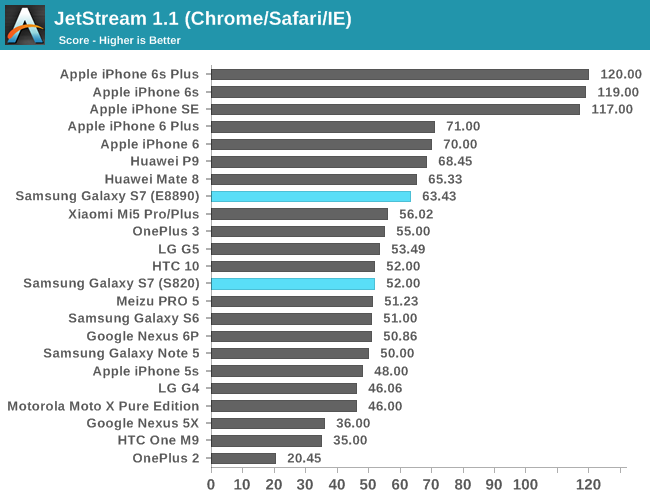
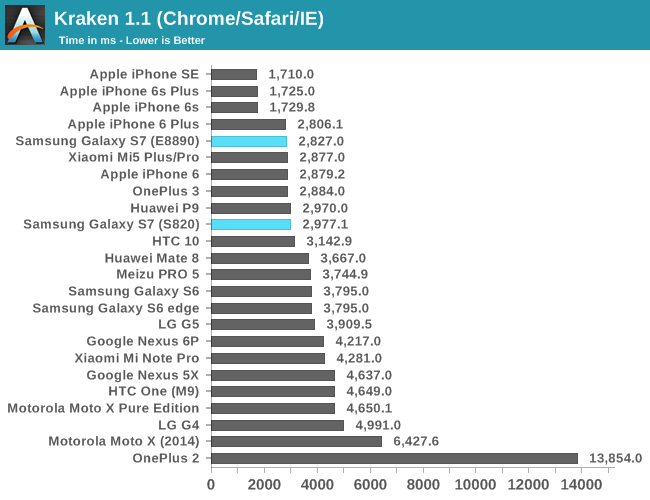

In browser/JavaScript performance the Galaxy S7 in its Snapdragon 820 variants performs pretty much as you'd expect with fairly respectable performance about on par with the iPhone 6 at least part of the time, which frankly still isn't enough but a lot of this is more due to Google's lack of optimization in Chrome than anything else. The Exynos 8890 version comes a lot closer but it still isn't great. Subjectively browsing performance on the Galaxy S7 with the Snapdragon 820 is still painful with Chrome, and I have to install either a variant of Snapdragon Browser or Samsung's stock browser in order to get remotely acceptable performance. Even then, performance isn't great when compared to Apple's A9-equipped devices. The lack of single thread performance relative to other devices on the market in conjunction with poor software optimization on the part of Google is really what continues to hold OEMs back here rather than anything that Samsung Mobile is capable of resolving.
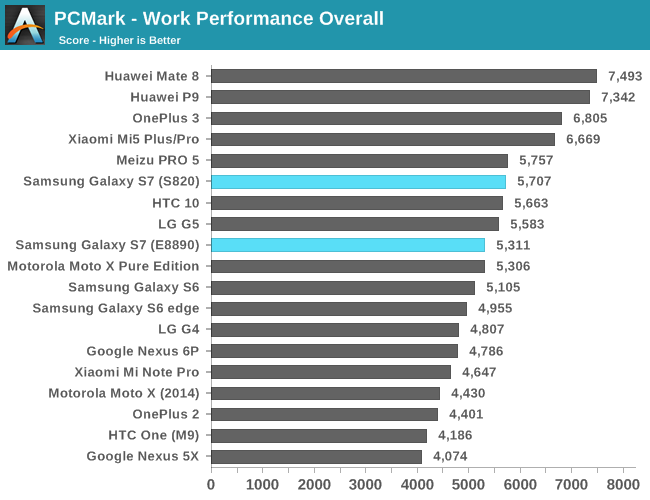
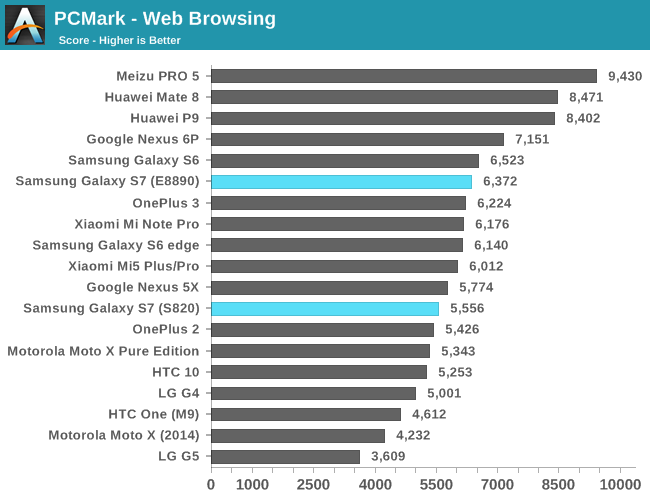
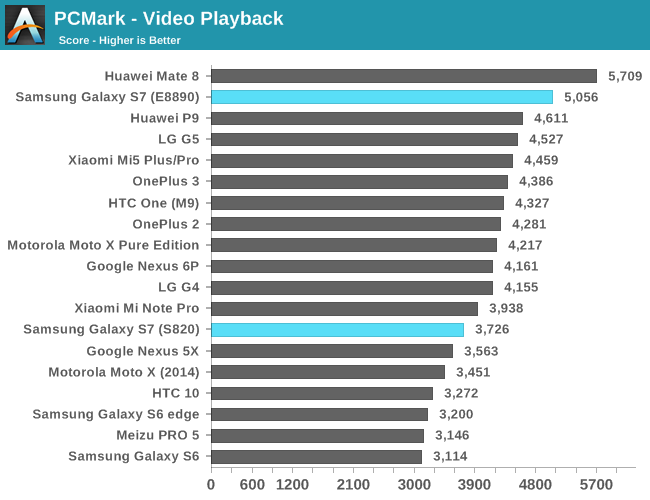
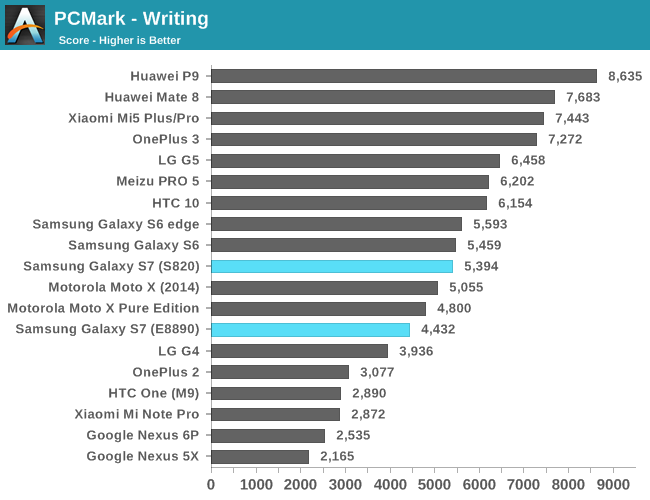
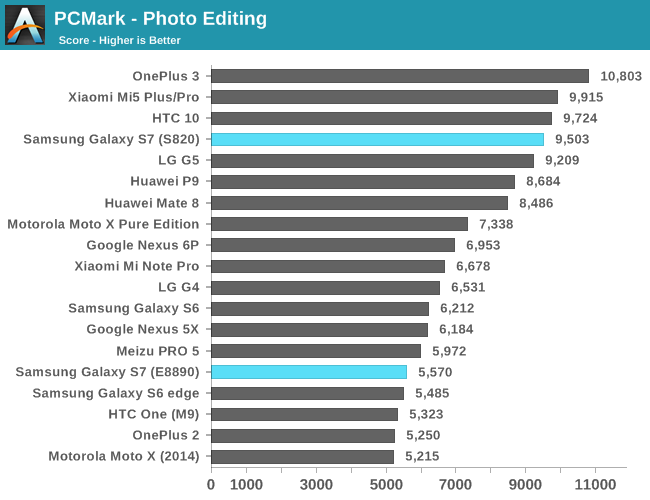
PCMark shows that the Galaxy S7 is generally well-optimized, with good performance in native Android APIs, although devices like the OnePlus 3 pull ahead in general, likely due to differences in DVFS, lower display resolution, more RAM, and similar changes as the hardware is otherwise quite similar. In general though unless you get something with a Kirin 95x in it you aren't going to get performance much better than what you find in the Galaxy S7, although the software optimization in cases like the writing test could be better for the Snapdragon 820 version of the phone.
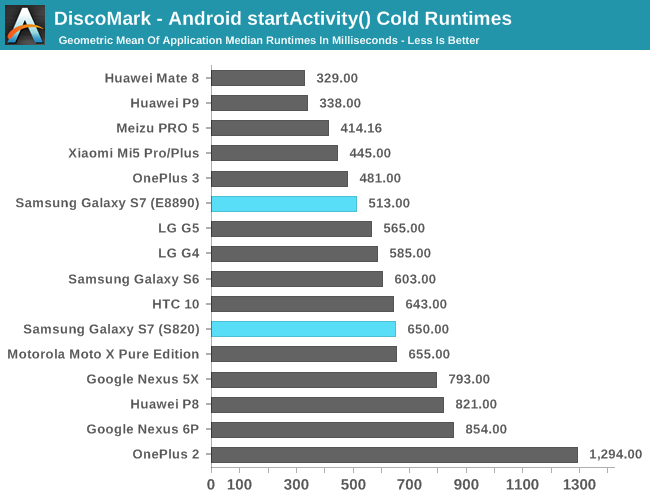
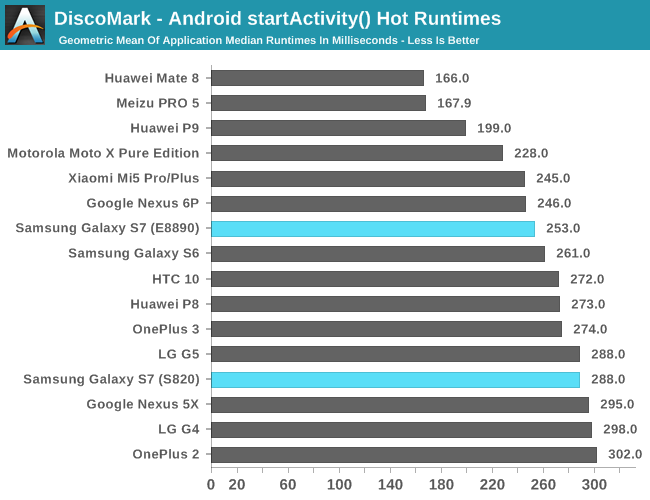
As hinted by the PCMark results, the Galaxy S7 with the Snapdragon 820 is really nothing to write home about when it comes to actual software optimizations, while the Exynos 8890 version is significantly faster in comparison. The fastest devices by far here are still the Kirin 950-equipped phones, but even from cold start launches the HTC 10 is comparable, and pulls ahead slightly when the applications are pre-loaded into memory. The OnePlus 3 and Xiaomi Mi5 are closer to what the S820 GS7 should be achieving, which is really more a testament to just how strangely slow the Galaxy S7 with Snapdragon 820 is.
Overall though, the Galaxy S7 in both iterations are acceptably fast for general purpose tasks. However, with that said the Snapdragon 820 variant is noticeably slower, and the software stack seems to be less optimized for whatever reason even after multiple post-launch OTAs and all the latest app updates. Given that these devices have locked bootloaders it's difficult to really go deep and try to figure out exactly what's causing these issues, but it's likely that Samsung Mobile has the engineering staff to do this and resolve these issues as a 600 USD phone really shouldn't be performing worse than a 400 USD phone. On the bright side, the Exynos 8890 variants perform quite well here, with performance comparable to top devices and often beating out Snapdragon 820 devices, although usually not by a huge margin.


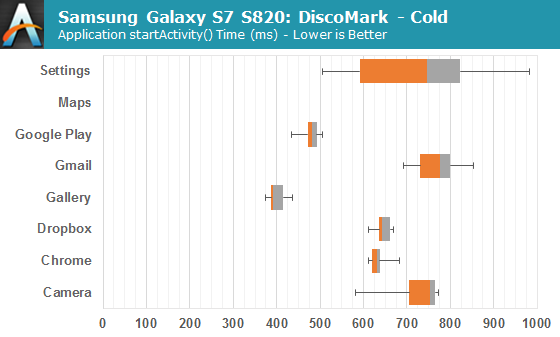
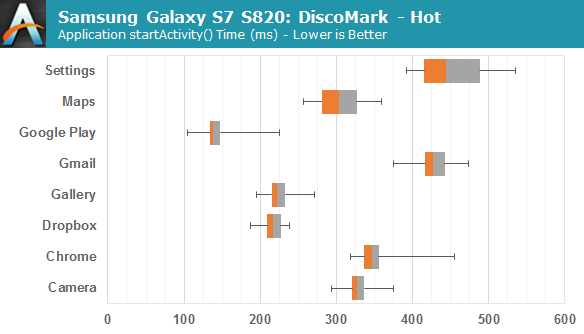








266 Comments
View All Comments
realbabilu - Thursday, July 7, 2016 - link
If we bought for performance. The lags or the speed of apps is quite small than last one or two years ago oneplus one s801, you can't fell it big difference unless on benchmarking apps.The photos can tell different story, you can know it good or bad than last year mobile or other features like ois
ntp - Thursday, July 7, 2016 - link
That's a very thoughtful reply, Impulses, thanks. But with the small sensors of smartphones I think 3/4ths of a stop is a significant advantage, more so than in the case of large sensor cameras, since we'd care about the F number in low light scenarios, where the ISO will be high. I'm just saying it should be better emphasized so people understand the real world advantages it gives.Impulses - Thursday, July 7, 2016 - link
It's a valid point, I'm just saying you can't look at that in a vacuum, specially since you're not looking at an ILC anyway... If you can't swap any parts, then the end result is all that really matters and that includes sensor efficiency, post processing (unless you're shooting RAW, a rarity on phone users), the presence of OIS, effectiveness of the latter, and even things like how smart the auto mode is...That last bit is probably beyond AT's more data driven evaluation, but a phone that relies to heavily on OIS for instance (or HDR) might take more blurry shots under real life conditions... That actually does favor a faster aperture but the point is emphasising specs in a vacuum is pointless.
mavsaurabh - Tuesday, July 12, 2016 - link
I just wish to reply regarding aperture , you rightly said that f no causes cost to skyrocket in case of lslr ens all else being equal, the catchphrase is all being equal ! In case of constraints of mobile photography, lens stack size & weight limitations, heat produced etc leads to various compromises like plastic lens which coupled with bigger apertures leads to higher corner aberration, diffraction etc etc. in end as Impulses wrote what matters is the end result which is fine tuned balance of various compromises made !I am a pixel peeper and street, landscape photgrapher by hobby with 25 years of film and digital shooting through Slr's , mobiles , compacts, Fuji X100.
My observation is that samsung uses hard sharpening and over saturated colors which "creates" pleasing photos on phone screen but if you display it on decent monitor and zoom to even 50% you will see various artefacts and no latitude for post processing. Now most of casual photographers will like larger than life portrayal or smearing of face pimples etc by clever use of face detection but hey any one who loves photography will differ!
I completely agree about fast focussing advantages but honestly i am yet to use a mobile camera with lens fast enough to freeze pet/ child movement in indoor light to take advantags of fast focussing.
Only phone which was able to do that with use of proper flash though is Nokia 808 Pureview and kudos to its mazing manual controls plus superb post processing which bettered apple even in natural post processing !
beggerking@yahoo.com - Wednesday, July 6, 2016 - link
please just stop those BS apple biased benchmarks at 10x lower resolution... just take them off the chart! its not even a good comparision and serves no uses.realbabilu - Thursday, July 7, 2016 - link
What you see on your screen mobile is what you get. Offscreen just measuring the gpu can do,basically it useless for user because you can't see it.lilmoe - Wednesday, July 6, 2016 - link
"The one notable shortfall here is that Samsung only allows 800 ISO max in manual ISO mode when the true maximum is 1250"I had that number in mind when I read it last night, and was too lazy to test. I've tested it now and my unit can go up to 1600 ISO. Is that also a variable difference in Samsung's sensor (mine is Samsung made), or is the extra third stop on mine extended?
Chris_m1296 - Wednesday, July 6, 2016 - link
Joshua ho, how did the exynos 8890 manage this score on slingshot es 3.1 unlimited? mine only got 2223 and even 3dmark themselves list the exynos version at 2223.UtilityMax - Wednesday, July 6, 2016 - link
Some people complain that the review is too harsh. But my personal view is that if this is a +650USD smartphone that _also_ happens to be carrier locked, it'd better be not just good, but _excellent_ in every respect. Otherwise, it's not clear what exactly justifies the price premium over a phone like Oneplus 3 or why a typical shopper should choose this over an apple product.Impulses - Thursday, July 7, 2016 - link
I kinda agree... I still feel some areas could've been better tested given how long the review date got dragged out, but there was still content here that's pretty unique to AT. I think the market, overall, is definitely giving the high end OEM too much of a pass given the prices phones are now commanding.A $1,000+ laptop with performance sapping bloat that the user can't remove (that aren't part of the core OS) would get ripped to shreds. It's time $700+ phones were held to the same standards.